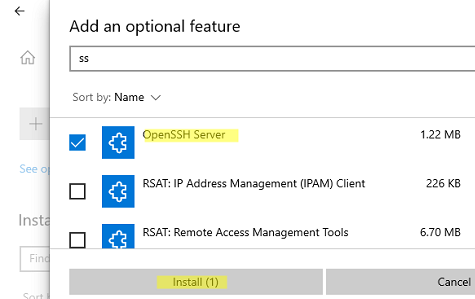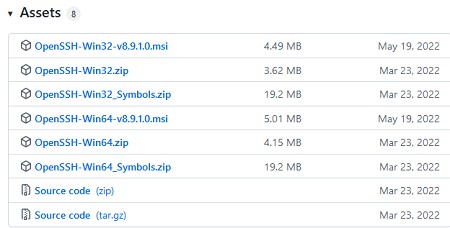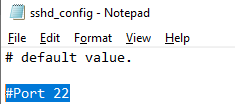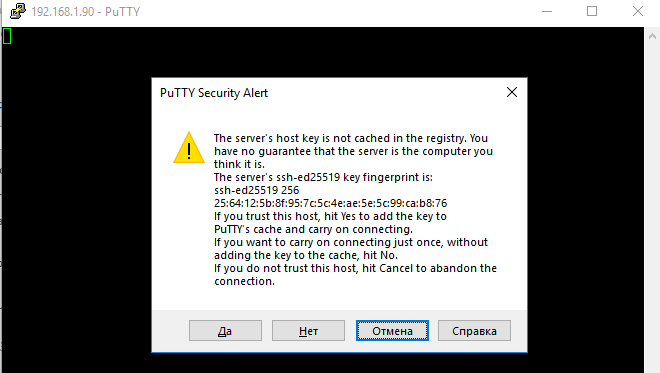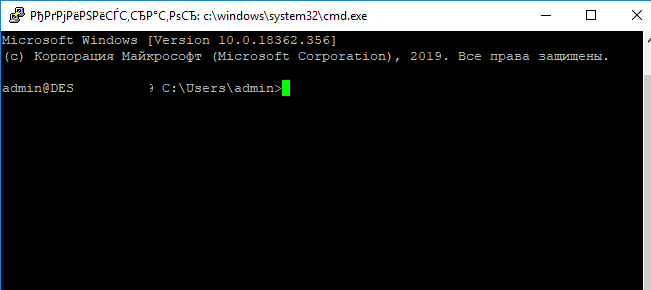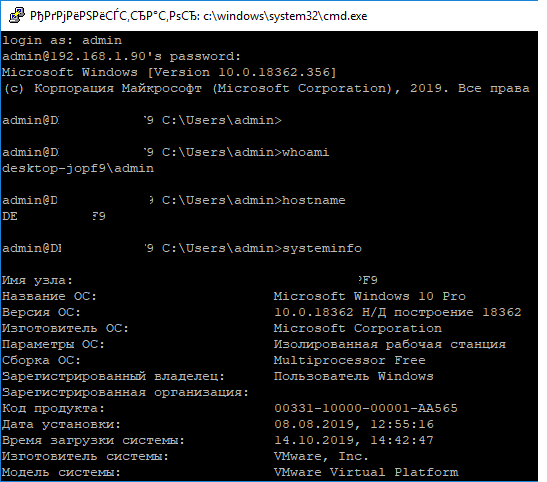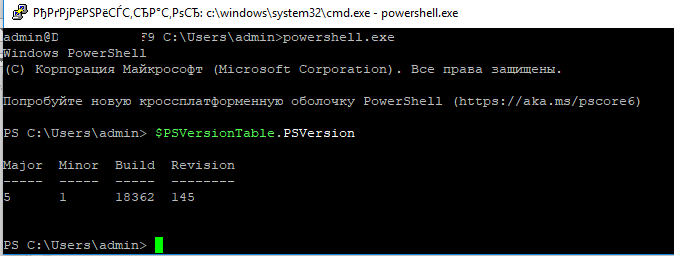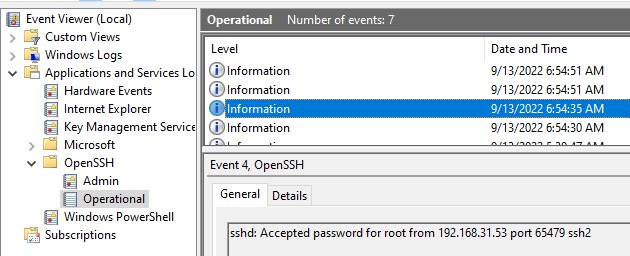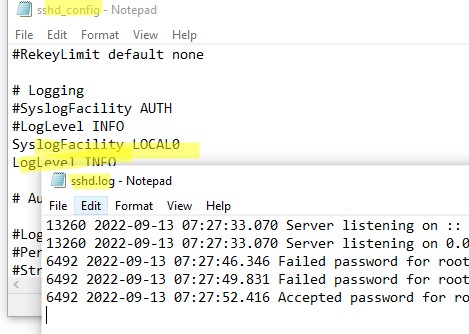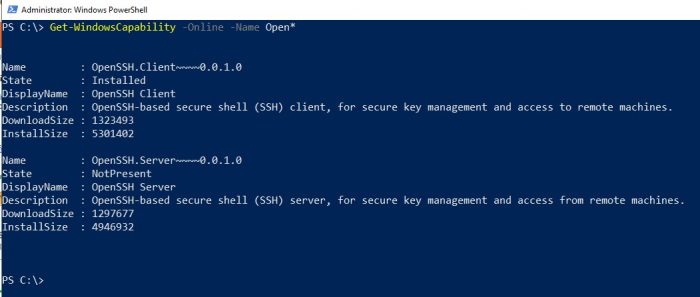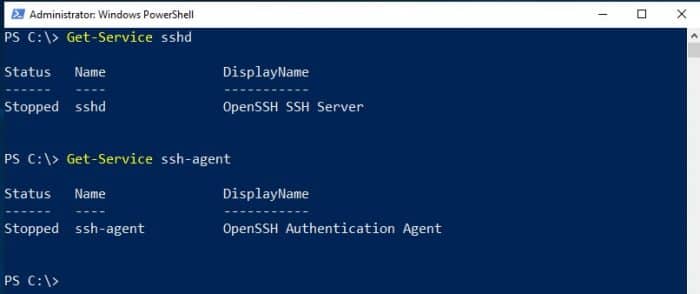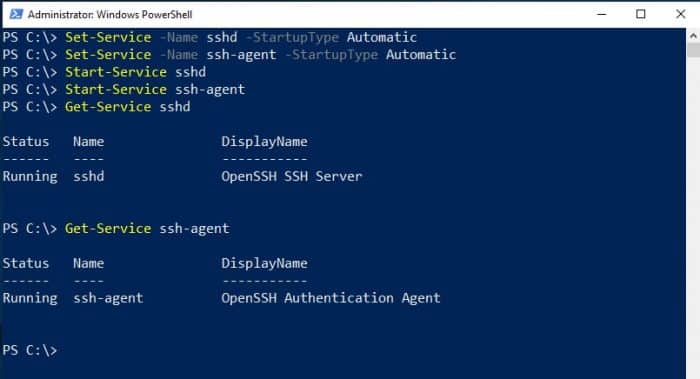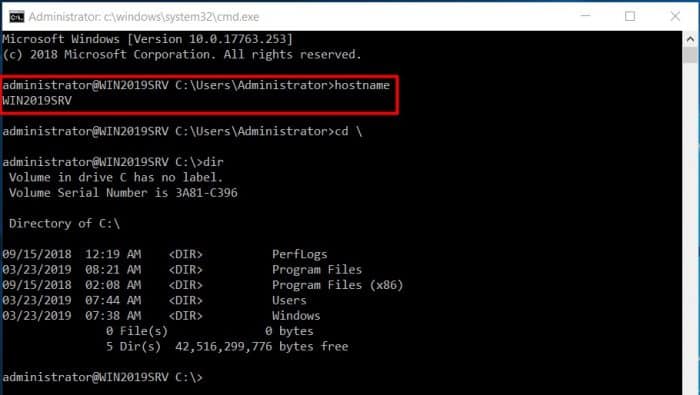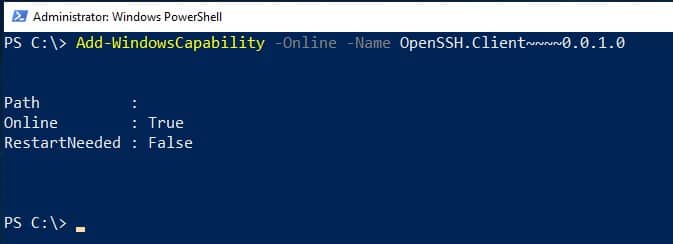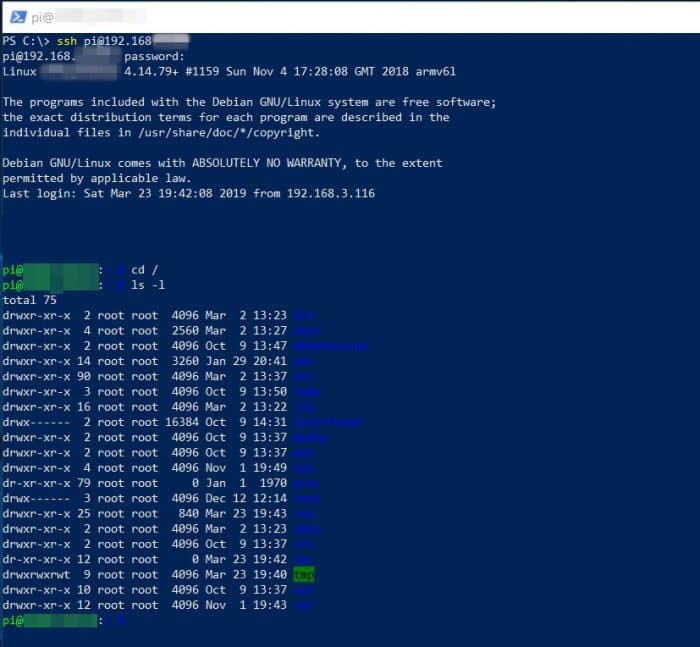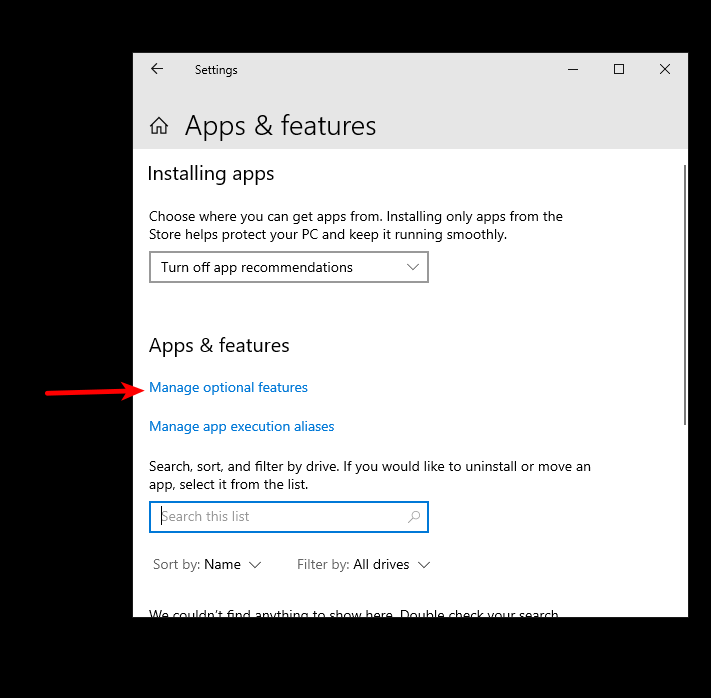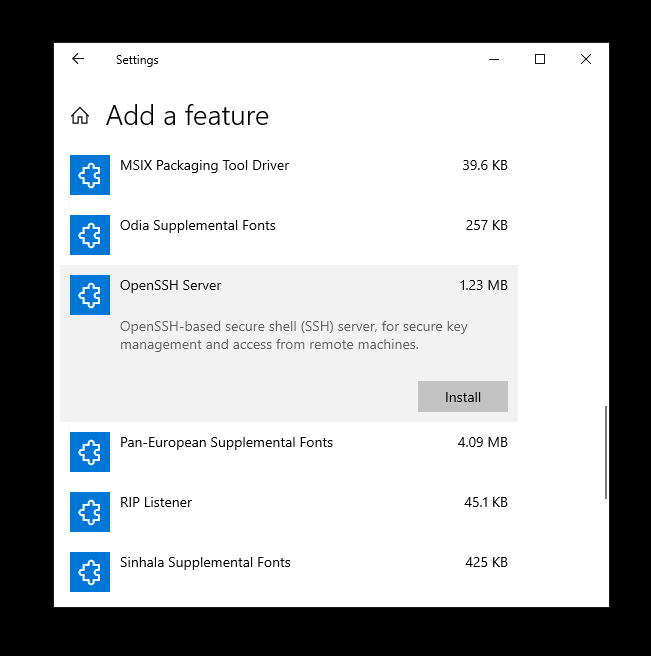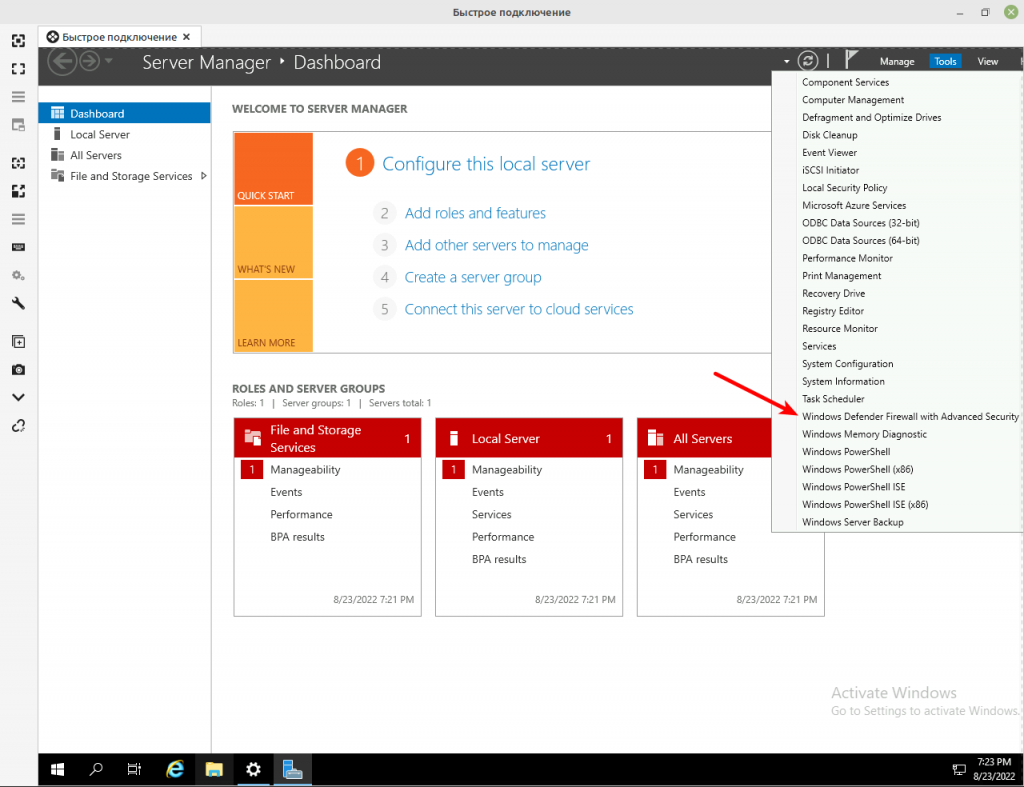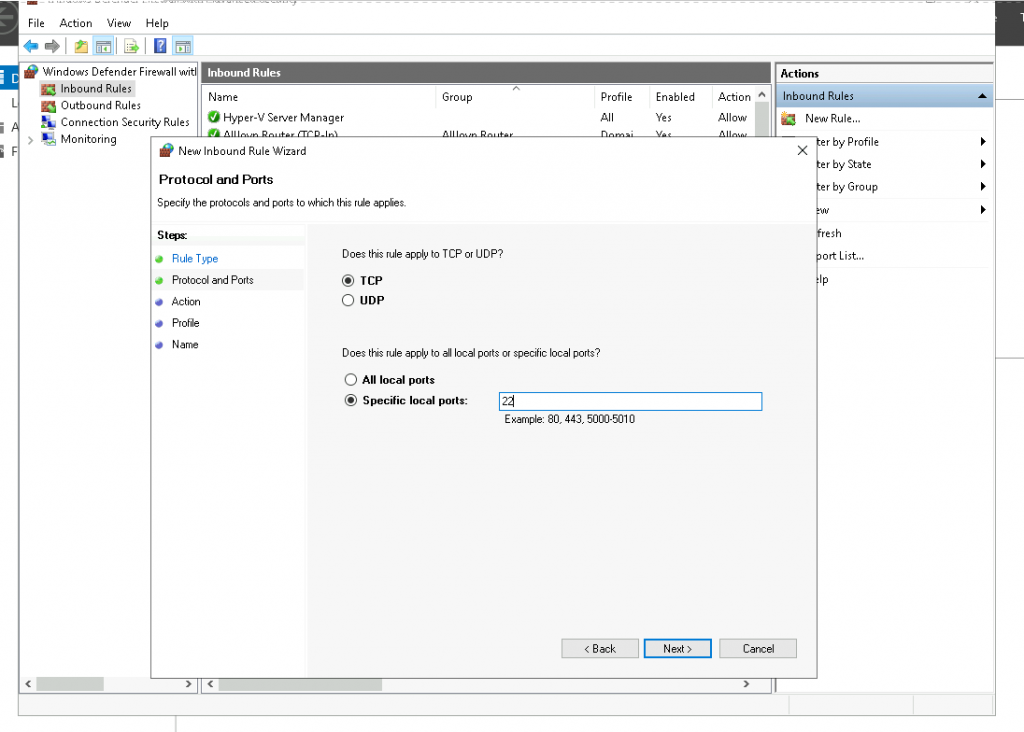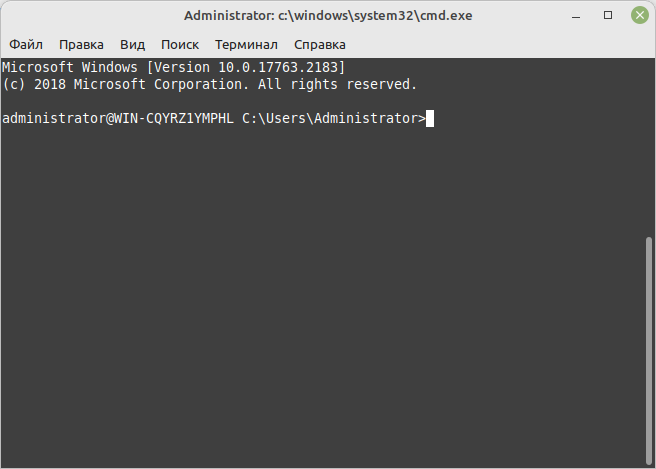2023 Update.
You’re better off looking at the following official documentation: https://learn.microsoft.com/en-us/windows-server/administration/openssh/openssh_install_firstuse
While I’ve never had a problem with PowerShell remoting for remote command line interaction with Windows Server, I’ve often found that it isn’t something that many systems administrators, especially those that work in heterogeneous environments, are entirely at ease with. I’ve lost count of the number of times that I’ve seen experienced admins RDP across to a box running Windows Server so that they can interact with the operating system through a command prompt.
Windows Server 2019 and the most recent version of Windows 10 include the ability to install both an SSH client and an SSH server. Because most of us work with heterogenous systems, we are familiar with SSH’ing into a server or device to perform admin tasks. Now that it’s available and easy to configure on Windows Server 2019, I find myself using SSH, rather than other remote connection methods, as my default method of remotely connecting to servers, be they proximate or running in Azure.
To get an SSH client onto Windows 10 or Windows Server 2019, without using 3rd party software or installing Windows Subsystem for Linux, use the PowerShell command:
Add-WindowsCapability -Online -Name OpenSSH.Client~~~~0.0.1.0
To add an SSH client and SSH server to Windows Server 2019, use the following PowerShell commands:
Add-WindowsCapability -Online -Name OpenSSH.Server~~~~0.0.1.0 Add-WindowsCapability -Online -Name OpenSSH.Client~~~~0.0.1.0
I have found it useful to add both client and server capability to Windows Server. This is also useful if the server will function a jump box. Once you’ve added the capability, you need to do a few things to get the SSH server working before you’re ready to go.
If you’re intending to use key based, rather than password based, authentication, you should also run the following command on the server to install an OpenSSH related PowerShell module that includes tools to help you configure that functionality:
Install-Module -Force OpenSSHUtils -Scope AllUsers
I also recommend running the following PowerShell commands on the server to install the Nano text editor, which allows you to edit text files through an SSH session. If you’re going to use key based authentication rather than passwords, you’ll need to edit one of the config files (I’ll explain what you need to do a little later in the article):
Set-ExecutionPolicy Bypass Iwr https://chocolatey.org/install.ps1 -UseBasicParsing | iex choco install nano -y
The next thing you’ll need to do on your server is to configure the disabled ssh-agent service to automatically start and also configure the sshd service to automatically start. To do this, run the following PowerShell commands:
Set-Service -Name ssh-agent -StartupType ‘Automatic’ Set-Service -Name sshd -StartupType ‘Automatic’
The final step in getting SSH running on Windows Server 2019 is to run the following commands to start the relevant services:
Start-Service ssh-agent Start-Service sshd
If you do all of this, you’ll be able to connect using password passed authentication from an SSH client using the syntax:
ssh username@hostname_or_IP_address
If you’re connecting to a domain account the format is
ssh username@domain@hostname_or_IP_address
The reality of SSH is that the vast majority of people that use it, use key based authentication rather than password based authentication. To get key based authentication working with Windows Server 2019’s SSH server, you’ll need to the following:
On the client change to the .ssh directory and run the command ssh-keygen accepting the defaults (you can change the name of the keys and provide a key password if you really want to, but that’s beyond the scope of this article)
Cd ~\.ssh\ Ssh-keygen
Doing this with the default values will create a public and private key. The private key will be id_rsa and the public key will be id_rsa.pub.
The next thing you should do is add your private key to your Windows security context. You can do this by running the following three commands:
Set-Service ssh-agent -StartupType ‘Automatic’ Start-service ssh-agent Ssh-add ~\.ssh\id_rsa
Once you’ve done this, you’ll want to deploy your public key to the Windows Server 2019 server that you want to use SSH key based authentication with. To do this, perform the following steps (where chancellor is the name of the user account you’re configuring SSH key based authentication for):
Ssh chancellor@172.16.0.15 mkdir c:\users\chancellor\.ssh\ Scp c:\users\chancellor\.ssh\id_rsa.pub chancellor@172.16.0.15:C:\Users\Administrator\.ssh\authorized_keys
You’ll then need to run the following PowerShell command, located in that OpenSSHUtils PowerShell module I mentioned earlier, to configure some of the permissions for the authorized keys file. You might even want to SSH across to the server using password based authentication to do this:
Repair-AuthorizedKeyPermission C:\users\Chancellor\.ssh\authorized_keys
Because the PowerShell cmdlet doesn’t entirely work as it should, you’ll also need to run the following command as “NT SERVICE\sshd” should not have any permissions to the authorized_keys file (if it does, key based authentication doesn’t seem to work)
Icacls authorized_keys /remove “NT SERVICE\sshd”
The final step you’ll need to take requires you to edit the c:\ProgramData\ssh\sshd_config file, which you can do using the nano text editor and comment out the following lines (which are at the end of the file):
# Match Group administrators # AuthorizedKeysFile __PROGRAMDATA__/ssh/administrators_authorized_keys
You may need to do this locally on the Windows Server 2019 box. Once this is done, you can restart the sshd service (restart-service sshd) and you will be able to connect from your client using key based authentication.
If you want to learn about advanced configuration options for OpenSSH server on Windows Server 2019, consult the following article: https://docs.microsoft.com/en-us/windows-server/administration/openssh/openssh_server_configuration?…
В современных версиях Windows уже есть встроенный SSH сервер на базе пакета OpenSSH. В этой статье мы покажем, как установить и настроить OpenSSH сервер в Windows 10/11 и Windows Server 2022/2019 и подключиться к нему удаленно по защищенному SSH протоколу (как к Linux).
Содержание:
- Установка сервера OpenSSH в Windows
- Настройка SSH сервера в Windows
- Sshd_config: Конфигурационный файл сервера OpenSSH
- Подключение по SSH к Windows компьютеру
- Логи SSH подключений в Windows
Установка сервера OpenSSH в Windows
Пакет OpenSSH Server включен в современные версии Windows 10 (начиная с 1803), Windows 11 и Windows Server 2022/2019 в виде Feature on Demand (FoD). Для установки сервера OpenSSH достаточно выполнить PowerShell команду:
Get-WindowsCapability -Online | Where-Object Name -like ‘OpenSSH.Server*’ | Add-WindowsCapability –Online
Или при помощи команды DISM:
dism /Online /Add-Capability /CapabilityName:OpenSSH.Server~~~~0.0.1.0
Если ваш компьютер подключен к интернету, пакет OpenSSH.Server будет скачан и установлен в Windows.
Также вы можете установить сервер OpenSSH в Windows через современную панель Параметры (Settings -> Apps and features -> Optional features -> Add a feature, Приложения -> Управление дополнительными компонентами -> Добавить компонент. Найдите в списке OpenSSH Server и нажмите кнопку Install).
На изолированных от интернета компьютерах вы можете установить компонент с ISO образа Features On Demand (доступен в личном кабинете на сайте Microsoft: MSDN или my.visualstudio.com). Скачайте диск, извлеките его содержимое в папку c:\FOD (достаточно распаковать извлечь файл
OpenSSH-Server-Package~31bf3856ad364e35~amd64~~.cab
), выполните установку из локального репозитория:
Add-WindowsCapability -Name OpenSSH.Server~~~~0.0.1.0 -Online -Source c:\FOD
Также доступен MSI установщик OpenSSH для Windows в официальном репозитории Microsoft на GitHub (https://github.com/PowerShell/Win32-OpenSSH/releases/). Например, для Windows 10 x64 нужно скачать и установить пакет OpenSSH-Win64-v8.9.1.0.msi. Следующая PowerShell команда скачает MSI файл и установит клиент и сервер OpenSSH:
Invoke-WebRequest https://github.com/PowerShell/Win32-OpenSSH/releases/download/v8.9.1.0p1-Beta/OpenSSH-Win64-v8.9.1.0.msi -OutFile $HOME\Downloads\OpenSSH-Win64-v8.9.1.0.msi -UseBasicParsing
msiexec /i c:\users\root\downloads\OpenSSH-Win64-v8.9.1.0.msi
Также вы можете вручную установить OpenSSH сервер в предыдущих версиях Windows (Windows 8.1, Windows Server 2016/2012R2). Пример установки Win32-OpenSSH есть в статье “Настройка SFTP сервера (SSH FTP) в Windows”.
Чтобы проверить, что OpenSSH сервер установлен, выполните:
Get-WindowsCapability -Online | ? Name -like 'OpenSSH.Ser*'
State : Installed
Настройка SSH сервера в Windows
После установки сервера OpenSSH в Windows добавляются две службы:
- ssh-agent (OpenSSH Authentication Agent) – можно использовать для управления закрытыми ключами если вы настроили SSH аутентификацию по ключам;
- sshd (OpenSSH SSH Server) – собственно сам SSH сервер.
Вам нужно изменить тип запуска службы sshd на автоматический и запустить службу с помощью PowerShell:
Set-Service -Name sshd -StartupType 'Automatic'
Start-Service sshd
С помощью nestat убедитесь, что теперь в системе запущен SSH сервер и ждет подключений на порту TCP:22 :
netstat -na| find ":22"
Проверьте, что включено правило брандмауэра (Windows Defender Firewall), разрешающее входящие подключения к Windows по порту TCP/22.
Get-NetFirewallRule -Name *OpenSSH-Server* |select Name, DisplayName, Description, Enabled
Name DisplayName Description Enabled ---- ----------- ----------- ------- OpenSSH-Server-In-TCP OpenSSH SSH Server (sshd) Inbound rule for OpenSSH SSH Server (sshd) True
Если правило отключено (состоянии Enabled=False) или отсутствует, вы можете создать новое входящее правило командой New-NetFirewallRule:
New-NetFirewallRule -Name sshd -DisplayName 'OpenSSH Server (sshd)' -Enabled True -Direction Inbound -Protocol TCP -Action Allow -LocalPort 22
Рассмотрим, где храниться основные компоненты OpenSSH:
- Исполняемые файлы OpenSSH Server находятся в каталоге
C:\Windows\System32\OpenSSH\
(sshd.exe, ssh.exe, ssh-keygen.exe, sftp.exe и т.д.) - Конфигурационный файл sshd_config (создается после первого запуска службы):
C:\ProgramData\ssh - Файлы authorized_keys и ssh ключи можно хранить в профиле пользователей:
%USERPROFILE%\.ssh\
Sshd_config: Конфигурационный файл сервера OpenSSH
Настройки сервере OpenSSH хранятся в конфигурационном файле %programdata%\ssh\sshd_config. Это обычный текстовый файл с набором директив. Для редактирования можно использовать любой текстовый редактор (я предпочитаю notepad++). Можно открыть с помощью обычного блокнота:
start-process notepad C:\Programdata\ssh\sshd_config
Например, чтобы запретить SSH подключение для определенного доменного пользователя (и всех пользователей указанного домена), добавьте в конце файле директивы:
DenyUsers winitpro\[email protected] DenyUsers corp\*
Чтобы разрешить подключение только для определенной доменной группы:
AllowGroups winitpro\sshadmins
Либо можете разрешить доступ для локальной группы:
AllowGroups sshadmins
По умолчанию могут к openssh могут подключаться все пользователи Windows. Директивы обрабатываются в следующем порядке: DenyUsers, AllowUsers, DenyGroups,AllowGroups.
Можно запретить вход под учетными записями с правами администратора, в этом случае для выполнения привилегированных действий в SSH сессии нужно делать runas.
DenyGroups Administrators
Следующие директивы разрешают SSH доступ по ключам (SSH аутентификации в Windows с помощью ключей описана в отдельной статье) и по паролю:
PubkeyAuthentication yes PasswordAuthentication yes
Вы можете изменить стандартный SSH порт TCP/22, на котором принимает подключения OpenSSH в конфигурационном файле sshd_config в директиве Port.
После любых изменений в конфигурационном файле sshd_config нужно перезапускать службу sshd:
restart-service sshd
Подключение по SSH к Windows компьютеру
Теперь вы можете попробовать подключиться к своей Windows 10 через SSH клиент (в этом примере я использую putty).
Вы можете использовать встроенный SSH клиентом Windows для подключения к удаленному хосту. Для этого нужно в командной строке выполнить команду:
ssh [email protected]
В этом примере
alexbel
– имя пользователя на удаленном Windows компьютере, и 192.168.31.102 – IP адрес или DNS имя компьютера.
Обратите внимание что можно использовать следующие форматы имен пользователей Windows при подключении через SSH:
-
alex@server1
– локальный пользователь Windows -
[email protected]@server1
–пользователь Active Directory (в виде UPN) или аккаунт Microsoft/ Azure(Microsoft 365) -
winitpro\alex@server1
– NetBIOS формат имени
В домене Active Directory можно использовать Kerberos аутентификацию в SSH. Для этого в sshd_config нужно включить параметр:
GSSAPIAuthentication yes
После этого можно прозрачно подключать к SSH сервер с Windows компьютера в домене из сессии доменного подключается. В этом случае пароль пользователя не указывается и выполняется SSO аутентификация через Kerberos:
ssh -K server1
При первом подключении появится стандартный запрос на добавление узла в список известных SSH хостов.
Нажимаем Да, и в открывшееся окне авторизуемся под пользователем Windows.
При успешном подключении запускается командная оболочка cmd.exe со строкой-приглашением.
admin@win10tst C:\Users\admin>
В командной строке вы можете выполнять различные команды, запускать скрипты и программы.
Я предпочитаю работать в командной строке PowerShell. Чтобы запустить интерпретатор PowerShell, выполните:
powershell.exe
Чтобы изменить командную оболочку (Shell) по умолчанию в OpenSSH с cmd.exe на PowerShell, внесите изменение в реестр такой командой:
New-ItemProperty -Path "HKLM:\SOFTWARE\OpenSSH" -Name DefaultShell -Value "C:\Windows\System32\WindowsPowerShell\v1.0\powershell.exe" -PropertyType String –Force
Осталось перезапустить SSH подключение и убедиться, что при подключении используется командный интерпретатор PowerShell (об этом свидетельствует приглашение
PS C:\Users\admin>
).
В SSH сессии запустилась командная строка PowerShell, в которой работают привычные функции: авто дополнение, раскраска модулем PSReadLine, история команд и т.д. Если текущий пользователь входит в группу локальных администраторов, то все команды в его сессии выполняются с повышенными правами даже при включенном UAC.
Логи SSH подключений в Windows
В Windows логи подключений к SSH серверу по-умолчанию пишутся не в текстовые файлы, а в отдельный журнал событий через Event Tracing for Windows (ETW). Откройте консоль Event Viewer (
eventvwr.msc
>) и перейдите в раздел Application and services logs -> OpenSSH -> Operational.
При успешном подключении с помощью к SSH серверу с помощью пароля в журнале появится событие:
EventID: 4 sshd: Accepted password for root from 192.168.31.53 port 65479 ssh2
Если была выполнена аутентификация с помощью SSH ключа, событие будет выглядеть так:
sshd: Accepted publickey for locadm from 192.168.31.53 port 55772 ssh2: ED25519 SHA256:FEHDEC/J72Fb2zC2oJNb45678967kghH43h3bBl31ldPs
Если вы хотите, чтобы логи писались в локальный текстовый файл, нужно в файле sshd_config включить параметры:
SyslogFacility LOCAL0 LogLevel INFO
Перезапустите службу sshd и провеьте, что теперь логи SSH сервера пишутся в файл C:\ProgramData\ssh\logs\sshd.log
Прежде всего, вы можете спросить, зачем нам вообще нужен SSH-сервер на Windows-сервере? В среде Windows SSH может показаться не очень полезным. В конце концов, у нас есть RDP и PowerShell Remoting с WinRM, которые уже обеспечивают мощные возможности удаленного управления. Тем не менее, SSH в Windows определенно имеет свои преимущества. Среди них можно выделить такие вещи, как:
- Простое подключение и управление Windows-серверами из Linux или MacOS с помощью встроенных инструментов.
- Подключение из систем Windows к серверам Linux — это простое решение с интегрированным SSH-клиентом. Есть много администраторов Linux, которые должны управлять серверами на работе с помощью ОС Windows, и всегда должны устанавливать некоторые дополнительные инструменты, такие как PuTTY или WinSCP. Теперь они могут использовать знакомые команды SSH прямо из командной строки Windows.
- Используются те же инструменты удаленного управления для серверов Linux и Windows (SSH, SCP, аутентификация с открытым ключом и т. д.).
- Кроссплатформенный PowerShell Remoting. PowerShell Core использует SSH для включения удаленного сеанса PowerShell в Windows, MacOS и Linux. В отличие от WinRM PowerShell Remoting — Windows PowerShell работает только на Windows.
- Вместе с подсистемой Windows для Linux вы можете получить Linux-подобные сеансы SSH с Bash и обычные инструменты Linux также на сервере Windows, который позволяет администраторам Linux использовать свои знания для управления системами Windows.
- И наоборот: администраторы Windows могут использовать PowerShell для управления сервером Linux, если на нем будет присутствовать соответствующий shell от Microsoft.
- Просто другой вариант для удаленного управления, который дает еще большую гибкость.
Установка OpenSSH в Windows Server 2019
- Используя GUI
Открываем Settings — Apps & features — Manage optional features:
Нажимаем Add a feature, ищем OpenSSH Server — Install:
На предыдущем экране дожидаемся окончания процесса инсталляции. OpenSSH сервер можем считать установленным.
Обращаем внимание, что установка этим методом автоматически создаст правило Windows Firewall, с названием «OpenSSH-Server-In-TCP», открывающее 22 порт для входящих подключений.
Используя PowerShell:
Проверим, присутствует ли на нашей системе встроенный OpenSSH:
Get-WindowsCapability -Online | ? Name -like 'OpenSSH*'
В ответ должны получить:
Name : OpenSSH.Client~~~~0.0.1.0
State : NotPresent #или Install, если клиент уже установлен
Name : OpenSSH.Server~~~~0.0.1.0
State : NotPresent
Устанавливаем клиент, если он не установлен:
Add-WindowsCapability -Online -Name OpenSSH.Client~~~~0.0.1.0
Для установки сервера вводим:
Add-WindowsCapability -Online -Name OpenSSH.Server~~~~0.0.1.0
В обоих случаях вывод должен быть следующим:
Path :
Online : True
RestartNeeded : False
Первичная конфигурация SSH-сервера
По умолчанию при подключении к OpenSSH-серверу используется командная строка Windows. Вы можете использовать практически любую оболочку на вашем компьютере с Windows через SSH-соединение. Даже возможно использовать Bash, когда подсистема Windows для Linux (WSL) также установлена на целевой машине. Также возможно изменение оболочки по умолчанию на SSH-сервере на нечто иное, чем командная оболочка. Для этого ключ реестра «DefaultShell» необходимо изменить.
Сделать это можно как через редактор реестра regedit.exe, открыв в нем следующий путь: HKEY_LOCAL_MACHINESOFTWAREOpenSSH и изменив в нем параметр DefaultShell, указав в нем полный путь до исполняемого файла необходимой командной строки, например:
C:WindowsSystem32WindowsPowerShellv1.0powershell.exe
Тоже самое можно сделать используя PowerShell:
New-ItemProperty -Path "HKLM:SOFTWAREOpenSSH" -Name DefaultShell -Value "C:WindowsSystem32WindowsPowerShellv1.0powershell.exe" -PropertyType String -Force
Проверим настройки Windows Firewall, используя для этого PowerShell:
Get-NetFirewallRule -Name *ssh*
Введя данную команду мы получим параметры правила, разрешающего SSH-подключение к серверу. Если правила не оказалось, введем следующую команду, создав его:
New-NetFirewallRule -Name sshd -DisplayName 'OpenSSH Server (sshd)' -Enabled True -Direction Inbound -Protocol TCP -Action Allow -LocalPort 22
Запуск службы OpenSSH
После установки функции SSH-сервера нам остается только его запустить:
Start-Service sshd
Опционально можно установить для службы sshd автоматический запуск:
Set-Service -Name sshd -StartupType 'Automatic'
Подключение к серверу
Теперь мы готовы к работе и можем подключиться через установленное приложение к нашему хосту. Это можно осуществить либо с Windows 10, компьютера с Linux, с putty.exe на более старой машине с Windows, либо с Bash в настольной операционной системе от Microsoft. Все, что вам нужно, это найти какой-либо SSH-клиент, ввести в него имя пользователя, имя вашего сервера или IP-адрес и подключиться.
Для SSH-клиента в PowerShell синтаксис будет таким:
Ssh username@servername
При первом подключении с неизвестного хоста будет показано следующее сообщение:
Ответив на него yes, хост подключения будет добавлен в список известных хостов сервера. После чего необходимо ввести пароль пользователя (по соображениям безопасности вводимые символы отображаться не будут). После успешного подключения отобразится интерфейс используемой командной строки:
Копирование файлов
Также, как с сервером OpenSSH в любой системе * nix, вы можете использовать SCP для копирования файлов на сервер или с сервера.
Например, администратор Linux может быстро получить файл журнала с сервера Windows с помощью той же команды, что и для сервера Linux.
scp username@servername:C:/inetpub/logs/LogFiles/W3SVC1/u_ex191017.log u_ex191017.log
Когда вы подключаетесь из Bash/*nix к машине с Windows, нужно помнить, что пути Windows также должны указываться с обычными косыми чертами Unix вместо обратных косых черт. Например, C:/Windows вместо C:Windows.
sshd_config
Аналогично операционным системам семейства Linux, OpenSSH Server в Windows имеет в своем составе особый файл, где хранятся все параметры для выполнения более подробных настроек. Например, для ограничения входа.
По умолчанию файл конфигурации находится в «%programdata%sshsshd_config».
Самые различные настройки, применимые к этому файлу можно найти на сайте https://man.openbsd.org/sshd_config.
Кроме того, у Microsoft есть документация для специфичных настроек Windows.
Больше информации
Дополнительную информацию об OpenSSH в Windows можно найти на сайте docs.microsoft.com или в проекте GitHub разветвления OpenSSH от Microsoft.
191028
Санкт-Петербург
Литейный пр., д. 26, Лит. А
+7 (812) 403-06-99
700
300
ООО «ИТГЛОБАЛКОМ ЛАБС»
191028
Санкт-Петербург
Литейный пр., д. 26, Лит. А
+7 (812) 403-06-99
700
300
ООО «ИТГЛОБАЛКОМ ЛАБС»
Introduction
So, do you want native SSH in Windows Server? With Windows Server 2019, that is now possible!
SSH can be natively enabled on Windows Server 2019, both the SSH server and client! Although it does seem “illogical” to have SSH installed on a Windows Server machine, the truth is that, nowadays, our work environments are becoming more heterogeneous with each passing day, where Linux machines live side-by-side with Windows Server machines, making the possibility of having SSH on our Windows machines a great and welcoming addition!
Other than Windows Server 2019, it is also possible to enable SSH on Windows 10 starting with Windows 10 April 2018 Update (1803). What are you waiting for?
Besides OpenSSH, Windows Server 2019 brought us a lot other new features, which you can check out here: https://docs.microsoft.com/en-us/windows-server/get-started-19/whats-new-19
Install OpenSSH Server Windows Server 2019
Unfortunately, or no, it looks like we’ll have to get our hands “dirty”! It is not possible to add this feature via Server Manager (correct me if I’m wrong!) and we will have to add it via Powershell!
To get the name of the “package” to install, open a Powershell window as administrator and type:
Get-WindowsCapability -Online -Name Open*
You’ll see that we have available an Open SSH Server and an Open SSH Client.
Let’s start by installing the OpenSSH Server. Type the following in the Powershell window.
Add-WindowsCapability -Online -Name OpenSSH.Server~~~~0.0.1.0
Verify the OpenSSH server installation
To verify that the OpenSSH server is properly installed type:
Get-Service sshd
Get-Service ssh-agent
You will see that both services are in a “Stopped” status. Before starting the OpenSSH services, we need to enable them and set them to start at boot up. For that type:
Set-Service -Name sshd -StartupType Automatic
Set-Service -Name ssh-agent -StartupType Automatic
Now, let’s start both services. Type:
Start-Service sshd
Start-Service ssh-agent
Testing the connection to the SSH server
As stated previously, starting with Windows 10 1803, Windows 10 also comes with its own SSH client, which I already installed in my Windows 10 laptop. From here I am going to try to connect to the SSH server I’ve just installed in my Windows 2019 server.
On a Windows 10 machine, or Linux for that matter, open a command prompt (or terminal) and type:
ssh administrator@Win2019srv
(Win2019srv is the name of my Windows Server 2019 box)
Type “yes” at the warning message and press “Enter”
Type your password and you’re in! You can run any command you want as if you were sitting in front of your server box!
Now that we’ve confirmed that the OpenSSH server is working properly, let’s install the OpenSSH client!
Install OpenSSH Client Windows Server 2019
Back on the Windows Server 2019 computer, at the powershell prompt type:
Add-WindowsCapability -Online -Name OpenSSH.Client~~~~0.0.1.0
If you now type “ssh“, you’ll see that the OpenSSH client has been properly installed.
Testing the OpenSSH client
To test the OpenSSH I am going to connect to one of my Linux computers, which is a Raspberry Pi I have lying around :). So, from the server, I’ll type:
ssh pi@[IP address of my Linux box]
And that’s it! We have installed the OpenSSH server and the OpenSSH client on Windows Server 2019!
If you’d like some more reference about installing OpenSSH in Windows Server 2019, please take a look at this Microsoft’s TechCommunity blog post: https://techcommunity.microsoft.com/t5/ITOps-Talk-Blog/Installing-and-Configuring-OpenSSH-on-Windows-Server-2019/ba-p/309540
As always, if you found this article useful, share it with your friends.
If you have any questions or suggestions, leave your comment.
Thank you for reading!
Для того чтобы установить OpenSSH на Windows Server 2019 или 2022 найдите и откройте Windows Settings. В новом окне перейдите в раздел «Apps» и выберите «Select Optional Features» в разделе «Apps & Features».
Нажмите «Manage optional features», и выберите OpenSSH Server из полученного списка, затем нажмите «Install».
После установки запустите PowerShell от Администратора. Вставьте следующую команду для установки OpenSSH Server.
Add-WindowsCapability -Online -Name OpenSSH.Server
Установите OpenSSH Client:
Add-WindowsCapability -Online -Name OpenSSH.Client
Для настройки сервера можно использовать следующую команду, которая откроет блокнот и можно будет добавить свои изменения:
start-process notepad C:\Programdata\ssh\sshd_config
После всех настроек нужно запустить сервис командой:
Start-Service sshd
Далее необходимо будет настроить Firewall.
Для этого в меню “Пуск” находим “Server Manager”. Там выбираем “Tools” и клацаем на “Windows Defender Firewall with Advanced Security” в выпавшем списке.
Теперь кликаем на “Inbound Rules” в открывшемся окне и создаём новое правило “New Rule”. В окне “New Inbound Rule Wizard” выбираем “Protocol and Ports”, клацаем “TCP” и указываем порт 22 в “Specific local ports:”. После жмём Next, Next даём название правилу и нажимаем Finish.
Теперь всё готово к подключению по ssh.
Подключиться можно с любой машины – как с linux, так и с Windows. Достаточно ввести:
ssh -l Administrator SERVER-IP
Согласиться с парой ключей:
ECDSA key fingerprint is SHA256:Vv2A8NOfzCLR/e35Fm5UyqGeJptrn6ZlY6Vabx0wHXQ.
Are you sure you want to continue connecting (yes/no/[fingerprint])?
И вы можете работать на удалённом сервере по ssh, пример подключения с linux-машины.
Спасибо за чтение! Надеемся статья была для вас полезна.

